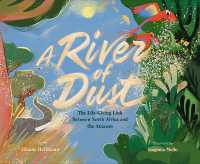- ホーム
- > 洋書
- > 英文書
- > Science / Mathematics
Full Description
After his famous visit to the Galapagos Islands, Darwin speculated that "one might fancy that, from an original paucity of birds in this archipelago, one species had been taken and modified for different ends." This book is the classic account of how much we have since learned about the evolution of these remarkable birds. Based upon over a decade's research, Grant shows how interspecific competition and natural selection act strongly enough on contemporary populations to produce observable and measurable evolutionary change. In this new edition, Grant outlines new discoveries made in the thirteen years since the book's publication. Ecology and Evolution of Darwin's Finches is an extraordinary account of evolution in action. Originally published in 1999. The Princeton Legacy Library uses the latest print-on-demand technology to again make available previously out-of-print books from the distinguished backlist of Princeton University Press. These editions preserve the original texts of these important books while presenting them in durable paperback and hardcover editions.
The goal of the Princeton Legacy Library is to vastly increase access to the rich scholarly heritage found in the thousands of books published by Princeton University Press since its founding in 1905.
Contents
Foreword xi Preface to the 1999 Edition xv Preface xvii ONE Introduction 3 Charles Darwin, 6 After Darwin, 9. The first synthesis, 9. Evolutionary inference, 10. Plan of the book, 12. TWO Characteristics of the Islands 19 Origins and ages, 19. Distribution and sizes, 21. Climate, 21. Plants, 2Z Vegetation, 28. Changes in the past, 29. Changes in recent times, 30. Cocos Island, 31 Summary, 31. THREE General Characteristics and Distributions of Finches 45 The main groups, 45. Genera, 51. Species, 51. Subspecies, 60. Distributions, 60. Patterns among the islands, 62. Extinctions, 64. Other land birds, 64. Summary, 65. FOUR Patterns of Morphological Variation 77 Introduction, 77. The major simple patterns, 77 The minor simple patterns, 79. Correlations between traits, 79. Size, 80. Allometry, 82. Shape, 82. Multivariate shape variation, 89. Geographical variation in size, 92. Summary, 95. FIVE Growth and Development 100 Introduction, 100. Variation in egg size, 100. Absolute growth, 102. Relative growth, 106. Summary, 111. SIX Beak Sizes, Beak Shapes, and Diets 113 Introduction, 113. Feeding mechanics, 113. Feeding types, 116. Ecological significance of beak differences between species, 117. Dietary differences between species, 118. Dietary differences between populations of the same species, 128. Dietary differences among individuals in a variable population, 132. Summary, 138. SEVEN The Importance of Food to Finch Populations 147 Introduction, 147. Plant phenology in the and zone, 147 Finch phenology, 148. Finch populations in relation to food supply, 152. Extreme conditions, 152. Food limitation of population sizes, 154. The frequency of food limitation, 168. Other factors limiting finch populations, 171. Interspecific competition for food, 173. Summary, 173. EIGHT Population Variation and Natural Selection 175 Introduction, 175. Relative variation, 175. Theoretical background, 177. Field studies, 180. Genetic variation, 180. Natural selection, 183. Sexual selection, 192. Countervailing selection, 193. A summary of selection pressures, 195. Sexual dimorphism, 196. Genetic drift, 197. Enhancement of genetic variation, 199, Variation in relation to abundance, 20Z Other species, 208. Summary, 219. NINE Species-Recognition and Mate Choice 222 Introduction, 222. The possible cues used in species-recognition, 222. Morphological cues, 224. Song, 251. Song and bill morphology as species cues, 241. Imprinting, 242. The learning of heterotypic song, 244. Misimprinting, 246 Beyond species-recognition: mate choice, 249. Summary, 251. TEN Evolution and Speciation 253 Evolution, 253. Origins, 253 The number of species, 256 The pattern of speciation, 257 The time framework 260. Allopatric speciation, 263. Alternative models of speciation, 273. Parapatric speciation, 274. Sympatric speciation, 275. Alternatives to gradual genetic change, 280. Conclusions and summary, 283. ELEVEN Ecological Interactions during Speciation 285 Introduction, 285. Ecological isolation, 285. Causes of initial differentiation, 286. An alternative view, 288. Differentiation entirely in allopatry, 289. The food supply hypothesis, 291. Lack's evidence for competition, 294. Tests of the competition hypothesis, 300. Different explanations reconciled, 310. Conclusions and summary, 312. TWELVE Competition and Finch Communities 314 Introduction, 314. Combinations of species, 315. Structure determined by competition, 317 Minimum differences between coexisting species, 321. Greater than minimum differences, 323. A digression on methods of analysis, and on bias, 328 Predictive models, 331. The classical case of character release, 340. Conclusions and summary, 346 THIRTEEN The Evolution of Reproductive Isolation 348 Introduction, 348. Experimental tests, 348. Implications of the experimental results, 350. Reinforcement? 353. Absence of speciesfrom islands, 354. Summary, 355. FOURTEEN Adaptation: Body Size, Plumage Coloration, and Other Traits 357 Introduction, 357 Historical survey, 358. Body size, 359. Plumage, 364. Otherfeatures, 371. Summary, 373. FIFTEEN Reconstruction of Phylogeny 375 Introduction, 375. Reconstructing the process of morphological divergence, 375. Comparison with contemporary selection, 379. Further evolution, 380. Ontogeny, 381. Phylogeny. 383. Summary, 387. SIXTEEN Recapitulation and Generalization 389 Introduction, 389. Patterns and processes among modem finches, 389. Evolution, 397 Generalizations, 401. APPENDIX: Spanish and English Names of the Major Galapagos Islands 413 Afterword 415 References 449 Author Index 471 Subject Index 476 Color Plates Following page 16





